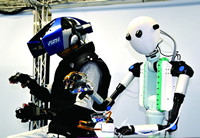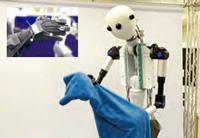
The userís movements (on left) are transmitted to the robot (on right), and the robotís haptic senses are transmitted to the user.

The feel of the cloth touched by the robot is transmitted to the userís glove (top left).
Project Professor Susumu Tachi and his associates of the Graduate School of Media Design of Keio University developed the worldís first remote controlled robot able to communicate fine haptic senses.
Remote-controlled robots have been coming into more use in recent years in disaster rescue operations, medical treatment and in other areas, but to control these robots freely and safely as the operatorís avatar, it is necessary to attain a sense of being there as if the operator were actually in the remote place where the robot is. Project Professor Tachi and his associates named the fundamental concept of this kind of haptic technology, “telexistence,” and they have been engaging in research and development since 1980.
In striving to realize “telexistence,” the research group has been working on technology which allows the movements of a user in a remote place to be transmitted to a robot, and conversely transmit haptic information from the robot to the user.
The telexistence system, “TELESAR V,” which is able to transmit the sense of touch and heat to the fingertips, was developed in 2011 after research was carried out in pursuit of not only transmission of sight and sound through cameras and microphones, but also the transmission of the sense of texture and temperature of objects picked up by the robotic hand. However, the system failed to allow the difference between the smoothness of silk and the roughness of denim to be distinguished.
This research group proposes the unique “principle of tactile primary colors” which suggests that just as all colors can be recreated by combining the three primary colors of red, blue and green, tactile senses can also be recreated by combining 7 types of sensory factors including the senses of pressure, temperature, and pain, with movement. Based on this principle, they succeeded in realizing telexistence with fine haptic senses being transmitted from remote environments by fusing “TELESAR V” with the senses of pressure and temperature so far developed, combined with new haptic technology for transmitting the sense of vibration. In the future, it is hoped that this technology will have a variety of applications for remote communication, remote travel and shopping experiences, working in extreme environments, and remote medical treatment, as well as applications in the fields of nursing, service industries and entertainment.

JST, an integrated organization of science and technology in Japan, establishes an infrastructure for the entire process from the creation of knowledge to the return to the society. For more information, visit http://www.jst.go.jp/EN/